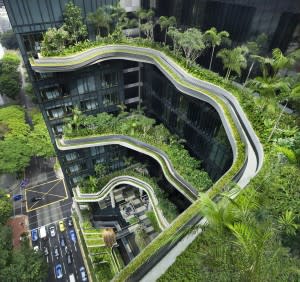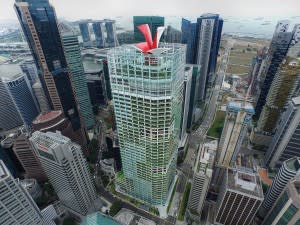Building a green city
View of Gardens by the Bay, a huge nature park in the city.
Singapore remains committed to reducing greenhouse gas emissions in the next 10 years. In line with this, several real estate companies are doing their part to build a more sustainable city.
By Romesh Navaratnarajah
At over 100ha, Gardens by the Bay is a sprawling oasis of nature that sits right next to luxury condominiums and office towers in the new downtown of Marina Bay. Opened in 2012, the nature park contains more than one million plants and draws busloads of tourists each day.
But the park is more than just a top tourist attraction. It highlights Singapore’s ongoing efforts to become one of the eco-friendliest cities in the world. For instance, the Supertrees at Gardens harvest solar energy used for lighting the towering structures at night. They also act as a collection point for rainwater used for irrigation.
The Republic’s bold plan to go green is nothing new.
“Singapore’s journey towards sustainability started in the 1960s before environmental issues became a global concern,” said Deputy Prime Minister Teo Chee Hean. “We made a conscious decision to green our country, clean up our streets, and enact laws against pollution.”
As part of the Paris climate agreement, Singapore is also looking to reduce greenhouse gas (GHG) emissions by 36 percent by 2030, Teo noted.
He was speaking at the opening of Singapore’s first sustainability academy in June. Jointly developed by property heavyweight City Developments Limited (CDL) and the Sustainability Energy Association of Singapore, the $2 million showpiece project located atop CDL’s City Square Mall in Farrer Park features about 3,200 sq ft of photovoltaic panels, and aims to promote a low-carbon economy, resource efficiency, and sustainable practices among businesses and the community.
It is also the first in Singapore to have its timber construction materials verified by the Nature’s Barcode system as coming from responsible sources.
A long track record
CDL began integrating sustainability into its business strategy back in 1995, and is just one of a handful of real estate firms here to do so. Other major players include CapitaLand, Lendlease and UOL Group.
“Today, integrating sustainability into a company’s business is indeed a must-have and not just a good-to-have,” said Esther An, Chief Sustainability Officer at CDL, who discussed sustainable design and developments at the recent Urban Land Institute Asia Pacific Summit held in Singapore.
She identified climate change as a key risk that could significantly impact the bottom line of businesses.
“In Singapore, businesses that do not adopt sustainable practices may face reputational or operational risks that will impact their license to operate, and be exposed to higher operating costs, with the water price increases and upcoming carbon tax.”
In 2009, CDL launched 11 Tampines Concourse, the first carbon neutral development in Asia Pacific, and was the first developer in the region to adopt the prefabricated prefinished volumetric construction method in 2014.
“We develop green buildings, manage them in an energy- and resource-efficient way, and engage stakeholders on sustainable development,” said An, adding that this has given it first-mover advantage.
Esther An, CDL Chief Sustainability Officer.
More awareness
Chunsheh Teo, Managing Director for Southeast Asia at global design firm smdp studio, believes sustainable building and construction is gaining momentum due to growing awareness of climate change.
At smdp, sustainability has become a core principle in all its designs through site placement, floor plan configuration and solar orientation. One of their most recent construction projects – the Samsung Headquarters in Beijing – features sky gardens which allow sunlight through and improves indoor air quality.
Teo noted that in the past, older buildings were designed and built to create a controlled environment for greater comfort, but this creates a disconnect between the interior and exterior environment and contributes to negative environmental effects.
“As cities get denser and populations increase contributing to horizontal and vertical sprawl, we build and consume more at the expense of the environment, which in return impacts our lives and future generations,” he told PropertyGuru.
Looking ahead, he believes that demand from consumers will push developers to provide more sustainable projects.
“This becomes a new segment for developers to market themselves, enhance their brand and compete to step beyond the traditional way of development,” said Teo, adding that governments also play an important role in introducing new guidelines, policies and regulations while offering incentives to developers and consumers.
Green financing
Meanwhile, the shift towards social responsibility has led to an increased appetite for alternative financing options such as green bonds.
In April this year, CDL became the first local company to launch a green bond. The two-year senior secured green bond raised $100 million at a fixed rate of 1.98 percent.
The proceeds will go towards refinancing a $100 million loan initially taken to construct and maintain Republic Plaza, a Grade A office building at Raffles Place which was awarded the highest Green Mark Platinum rating by the Building and Construction Authority (BCA) in 2012.
“Green finance offers CDL an alternative financing stream,” said An. “Our green bond issuance also complements the Singapore government’s target of greening at least 80 percent of the country’s building stock by 2030, which could be the lynchpin of Singapore’s climate change pledge to reduce GHG emissions.”
According to An, CDL will explore more green bond issuances in future.
“It is clear that for the next 13 years, real estate companies have a large role to play in mitigating climate change and contributing towards Singapore’s greening and GHG emissions reduction goals,” she said.
Singapore’s greenest buildings
More property developers are incorporating eco-friendly features in their new projects. These include bicycle facilities to reduce car dependency and energy-saving technologies. We look at four properties which have scored top marks for being green.
PARKROYAL on Pickering
Completed in 2013, the project at Upper Pickering is considered the first eco-friendly hotel in Singapore. It features over 160,000 sq ft of sky gardens and has won numerous awards including the Solar Pioneer Award and the BCA’s Green Mark Platinum Award.
The hotel achieves total energy savings of 3.5 million kilowatt hours per year, which is equivalent to the energy consumption of more than 8,500 households.
Developer: UOL Group
CapitaGreen
The 40-storey Grade A office building in the Central Business District was completed in 2014. Touted as one of the greenest commercial buildings in Singapore, it has won numerous awards including the Green Mark Platinum Award in 2012.
Over half of its façade is covered by plants, while a red and white sculptural petalled wind scoop crowns the building. This helps to draw in cooler air from the top of the tower, and channels it to the floors below.
Developers: CapitaLand, Capita Commercial Trust and Mitsubishi Estate Asia
Located close to the Lower Seletar Reservoir and Orchid Country Club, The Criterion in Yishun comprises 505 executive condominium (EC) units spread across 10 blocks.
Launched in 2015, it boasts more than 50 facilities including free-to-use electric bicycles with a solar charging station – a first for an EC project. This not only encourages residents to adopt a green mode of transport and reduce their carbon footprint, but also promotes a healthier and more active lifestyle.
Developers: CDL and TID
The $3.2 billion mixed-use project in Paya Lebar recently achieved the highest Green Mark Platinum rating for non-residential buildings. Slated for completion in 2019, the 4.0ha site offers more than 100,000 sq ft of green public spaces.
High efficiency water fittings and more efficient air-conditioning systems have been incorporated. There will also be end-of-trip facilities and bicycle parking spaces to promote cycling among office and retail tenants.
Developer: Lendlease
This article was first published in the print version PropertyGuru News & Views. Download PDFs of full print issues or read more stories now! | |||








